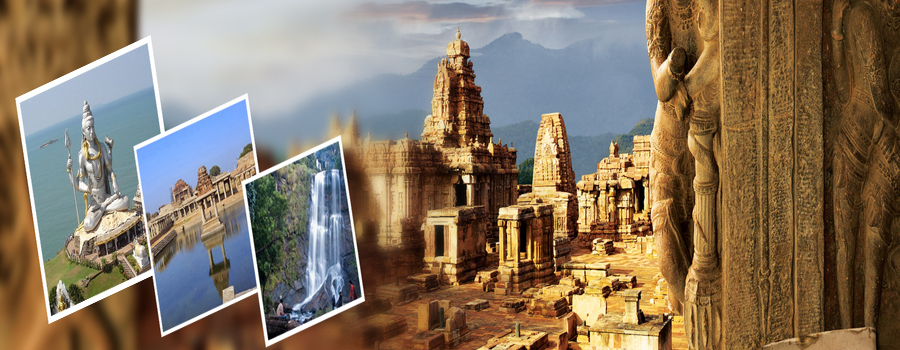

Diamonds and Dynasties of Southern India with beach
Places to See: Hyderabad – Bidar – Gulbarga – Bijapur – Badami – Aihole – Pattadakal – Hospe – Hampi – Goa – Mumbai

Diamonds and Dynasties of Southern India with beach: Complete Itinerary
Day 01: Hyderabad
Arrive Hyderabad airport, meet and greet with our office representative, assistance and transfer to hotel, check in. Rest day free for personal activities, relax etc. Overnight at hotel.
Day 02: Hyderabad
Explore this wondrous capital during the Hyderabad tour, a 400 year-old metropolitan city teeming with bustling-bazaars and Muslim monuments. Hyderabad: founded on the River Musi five miles east of Golconda, in 1591-92 by Muhammad Quli Qutb Shah. In the 16th century the city grew rapidly along the banks of river Musi. Many buildings sprang up along the River Musi and Golconda was the capital of the Qutb Shahi rulers. Hyderabad, under the Nizams, was the largest princely state in India. Area wise it was as big as England and Scotland put together. The State had its own currency, mint, railways, and postal system. There was no income tax. Soon after India gained independence, Hyderabad State merged with the Union of India. On November 1, 1956 the map of India was redrawn into linguistic states, and Hyderabad became the capital of Andhra Pradesh.
Golconda Fort of the most magnificent fortress complexes in India, once famous for its diamond mines. The history of Golconda Fort dates back to the early 13th century, when this south eastern part of the country was ruled by the Kakatiyas. It is built on a granite hill 120 metres high, and is surrounded by crenellated ramparts constructed of large masonry blocks weighing several tonnes. Qutub Shahi Tombs Quite close to the Golconda fort are the tombs of the seven Qutub Shahi rulers in the Ibrahim Bagh. Also visit Charminar an imposing monument, which reflects the glory of the Qutub Shahi dynasty. Grand Mecca Masjid oldest masjid in the city & the biggest.
Day 03: Hyderabad – Bidar – Gulbarga (250kms/5hrs)
Morning travel by road to Gulbarga enroute visiting Bidar, a tiny district steeped in history of India. Bidar has lots of historical monuments from Bahmani era. The structure of the great Mahmud Gawan Arabic University is reminiscent of the rich architecture of the Bahmani era. The Bidar Fort; situated next to the city is one of the biggest forts in India. Sultan Alla-Ud-Din Bahman of the Bahmanid Dynasty shifted his capital from Gulbarga to Bidar in 1427 and built his fort along with a number of Islamic monuments. Constructed on the edge of the plateau, has a haphazard quadrangular layout plan of 0.75 miles (1.21 km) in length and 0.5 miles (0.80 km) breadth. The peripheral length of the fort walls measure 4,500 yards (4,100 m). The walls, bastions, gates and barbicans of Bidar, though in ruins, are well preserved and considered as some of the most stylish in India. It is surrounded by a triple moat.
Jami Masjid; a large mosque, is without minarets or prominent domes. The mosque though simple in design but has a symmetrical plan with well organized constituent parts. Solah Khamba Masjid; (16 pillared mosque) with a notable dome built on a 16-sided drum in the fort was built in 1327. Its long prayer hall has nineteen passageways; each passage is five compartments deep. In plan, the mosque measures 295 feet (90 m) x 77 feet (23 m). The main prayer hall is supported by 18 piers; the other areas of the mosque are supported by 60 round piers. All the piers support a roof which has 84 domes. The domes are flat with features of pendentives. Massive circular columns supporting the structure are fashioned with leafy motifs at the top. The Mihrab (prayer niche) located on the rear wall is enclosed by a cusped arch.
On arrival into Gulbarga check-in at Hotel. Overnight at hotel.
Day 04: Gulbarga – Bijapur (152kms/ 3hrs)
Morning tour of Gulbarga. A Hindu city before the Muhammadan conquest, Gulbarga is a unique synthesis of two cultures. The city of Gulbarga was founded by the Bahmani Sultans in the 14th century as their capital. The northern Deccan, including the district of Gulbarga, passed under control of the Sultanate of Delhi. The revolt of the officers appointed from Delhi resulted in founding of the Bahmani Sultanate in 1347 by Hassan Gangu, who chose Gulbarga (Ahsenabad during this period) to be his capital. From 1724 to 1948 Gulbarga was part of Hyderabad state ruled by the famous Nizams. It was integrated into India in September 1948 after the Indian army defeated the Nizam. Gulbarga was known as 'kalburgi' in former days which means stony land in Kannada, but also means "rose petals" in poetic Persian.
Sharan basaveshwara temple is a famous Hindu temple which is located at the heart of the Gulbarga city. sharan was a guru and basav is shishya who upheld the relation of guru shishyas.
Hazrat Khwaja Bande Nawaz mausoleum built by the then Bahamani King Ahmed Shah Wali. The 14th century Sufi saint Khwaja Bande Nawaz was a disciple of Hazarath Khwaja Pir Naseeruddin Mahmood, who is also popularly known as Chirag of Delhi. Khwaja Bande Nawaz Gesudiraz played an important role in preaching Islam in the Indian context during the 14th century. Gulbarga's old moated fort is in a deteriorated state, but it has a number of interesting buildings inside including the Jama Masjid Gulbarga, reputed to have been built by a Moorish architect during the late 14th or early 15th century who imitated the great mosque in Cordoba, Spain. The mosque is unique in India, with a huge dome covering the whole area, four smaller ones at the corners, and 63 smaller still all the way around. The fort itself has 15 towers.
Later drive to Bijapur check-in at hotel.
Visit Gol Gumbaz: This is the most famous monument in Bijapur. It is the tomb of Mohammed Adil Shah (ruled 1627–1657). It is the second largest dome ever built, next in size only to St Peter's Basilica in Rome. A particular attraction in this monument is the central chamber, where every sound is echoed seven times. Another attraction at the Gol Gumbaz is the Whispering Gallery, where even minute sounds can be heard clearly 37 metres away. Gol Gumbaz complex includes a mosque, a Naqqar Khana (a hall for the trumpeters) (now it is used as museum) and the ruins of guest houses.
Ibrahim Rauza: This is the tomb of Ibrahim Adil Shah II (ruled 1580–1627), the fifth king of the dynasty and, like the Mughal emperor Akbar, known for religious tolerance. Built on a single rock bed, it is noted for the symmetry of its features. It is said that the design for the Ibrahim Rauza served as an inspiration for that of the famous Taj Mahal. Jumma Masjid: Built by Ali Adil Shah I (1558–80) is one of largest Mosque in the region. It has a large hall, elegant arches, and an excellent dome with thirty-three smaller domes surrounding it. It has an exquisite copy of the Quran, written in gold. Elaborate entrance gate was built by Emperor Aurangzeb.
The Gun Malik-E-Maidan; which means the master of the war front. Malik-e-Maidan (The Monarch of the Plains) the largest medieval cannon in the world. Being 4 m long, 1,5 m in diameter and weighing 55 tons, this gun was brought back from Ahmadnagar in the 17th century as a trophy of war by 400 oxen, 10 elephants and tens of men. It was placed on the Sherza Burj (Lion Gate) on a platform especially built for it. The cannon's nozzle is fashioned into the shape of a lion's head. It is said that after igniting the cannon, the gunner would remain underwater in a tank of water on the platform to avoid the deafening explosion. The cannon remains cool even in strong sunlight and if tapped, tinkles like a bell. Overnight at hotel.
Day 05: Bijapur – Badami (117kms/ 3hrs)
Morning travel by road to Badami and check-in at Hotel. Badami also known as Vatapi, is rich with Hindu and Jain temples carved out of sandstone hills. Badami, the capital of early Chalukyas is picturesquely situated at the mouth of a ravine between two rocky hills. Afternoon we make a short drive to visit the Cave temples – dedicated to Vishnu and Shiva. Climb a flight of steps to reach the ancient caves – all hewn out of sand stone on the precipice of a hill. Enter the first cave temple –past Shiva’s doorkeepers and there he is! The eighteen –armed Nataraja striking 81 dance poses. The largest and most ornamental is the third cave temple dedicated to Vishnu. Here are some splendid carvings of the Hindu pantheon. Narasimha – the half man half lion avatar of Vishnu, Hari Hara, the composite god who is half Siva and half Vishnu… There are also some paintings on the ceiling and wonderful bracket figures on the piers. Overlooking the cave temples is a reservoir and also visit the Bhootha Natha temples that lend their name to the lake just beneath the cave temples. Take a dip in this green tranquil lake. It is said to have healing properties. Overnight at hotel.
Day 06: Badami - Aihole - Pattadakal – Badami (39kms/ 1hrs one way)
Breakfast at hotel, full day tour to the elaborate temples at Aihole and Pattadakal.
Aihole UNESCO World heritage site; famous as the ‘Cradle of Indian Temple Architecture’, Aihole has over 100 temples scattered around the village. Wherever one looks, it’s temples that meet the eyes. Intricately carved, rich in detail, quiet and peaceful. Mute witnesses of a bygone era. Visit the oldest temple here is, perhaps, the Lad Khan temple dating back to the 5th century. On the roof of the temple is another shrine-like vimana. The Durga (Fort)Temple is notable for its semi-circular apse, elevated plinth and the gallery that encircles the sanctum. The interior is filled with fascinating carvings. Dating back to the 6th century the Ravalphadi Cave – Temple celebrates the many forms of Siva. Not-to-be-missed is the Konthi Temple Complex (Kwanthi Gudi), the Uma Maheshwari Temple, the Jain Meguti Temple and the two-storied Buddhist Temple. Climb up the stairs and you’ll come across a tranquil, smiling Buddha carved on the ceiling.
Pattadakal, a world Heritage centre, it has 10 major temples representing early Chalukyan architecture. Visit the biggest Temple here is dedicated to Virupaksha. Enclosed in a large quadrangle surrounded by small cells, it has a massive gateway and several inscriptions. Besides scenes from the Ramayana and Mahabaratha, there is a wonderful carving designed to look like an elephant from one side and a buffalo from the other. In front of the temple is a majestic 2.6 metres high Nandi made of deep green stone and is covered in a red floral cape. Stop now at the Malliarjuna and Papanatha temples- dedicatedly chiselled and rich in detail. The inner hall of the Papanatha temple is guarded by Nandi and Virabhadra. There are 16 pillars in the main hall with beautiful carvings. Besides these temples is a group of temples remarkable primarily, for representing two chief styles of Indian architecture, side by side. The detailed descriptions in the sculptors of the temples give an insight into the social life to those days. Back to Badami. Overnight at hotel.
Day 07: Badami – Hampi/ Hospet (131kms/ 3hrs)
Morning travel by road to Hospet and check-in at the Hotel, free for personal activities, visit the nearby small market town.
Evening visit The Tungabhadra Dam. TungaBhadra dam is constructed across river Tungabhadra, a tributary of River Krishna. The dam is built near the town of Hosapete in Karnataka. It is considered as a multipurpose dam or project. Its storage capacity is 135 Tmcft. Owing to siltation the capacity has been reduced by about 30 Tmcft. If there is seasonal and late rains, the dam distributes the estimated quantity of 235 Tmcft. The dam is filled as when the water is let into the canals during the rainy season. The main architect of the dam was Thirumalai Iyengar, an engineer from Madras. As Tungabhadra Dam was constructed by him, so a general-purpose hall in this place was named after him. Multipurpose dams are the ones which help in generation of electricity, irrigation of land, prevention and control of floods etc. It has become a picnic or tourist spot over the years. Overnight at hotel.
Day 08: Hospet / Hampi
Breakfast at hotel, full day to visit Hampi, also known as ‘The Fort Of Victory – Vijayanagara’, situated on the banks of the river Tungabhadra in the region of Bellary, is a vast site of monuments and ruins, a mute witness to an ear of glories, triumphs and tragedies. The ruins of Hampi, are so majestic and imposing that they leave the visitor totally dumbfounded, awestruck and humbled. Visit the Virupaksha Temple, rises majestically at the western end of a 670m long street that was once the famous Hampi bazaar. This is the only temple at Hampi that is still used for worship. The most splendid monument of Hampi is undoubtedly The Vitthala Temple Complex. The 56 pillars in the main hall produce musical notes when struck. To the east of the hall is the famous Stone Chariot with stone wheels that actually revolve! Hampi is full of such surprises. Back to Hospet, Overnight at hotel.
Day 09: Hospet – Goa (308kms/ 6hrs)
Breakfast at hotel, drive to Goa the final destination, with its endless beaches and swaying palms. On arrival at check-in at hotel. Rest day free for personal activities relax. Overnight at hotel.
Day 10: Goa
Breakfast at hotel, day at leisure for spending time on the beach, touring Goa on your own or relaxing at your resort hotel.
Day 11: Goa – Mumbai
Breakfast at hotel, transfer to airport for an afternoon flight to Mumbai. On arrival transfer to hotel.
Later city tour visit Gateway of India: which was conceived following the visit of King George V in 1911 and officially opened in 1924; Price of Wales Museum: designed in Indo Saracenic style and has sections for arts and paintings, archeology, natural history and an interesting collection of miniature paintings, bas reliefs from the Elephanta caves and Buddha images, Marine Drive: which runs along the shoreline, starting at Nariman Point and up to Malabar Hill, Hanging Gardens: laid out in 1881 these formally laid out gardens have a notable collection of hedges shaped like animals. Overnight at hotel.
Day 12: Depart Mumbai
Breakfast at hotel, transfer to airport to board flight for your onward destination.
Searching Availability...












